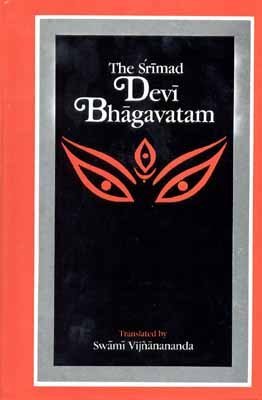The Devi Bhagavata Purana
by Swami Vijñanananda | 1921 | 545,801 words | ISBN-10: 8121505917 | ISBN-13: 9788121505918
The English translation of the Devi Bhagavata Purana. This Sanskrit work describes the Devi (Divine), the Goddess, as the foundation of the world and as identical with Brahman, the Supreme Being. The Devi Bhagavata Purana is one of the most important works in Shaktism, a branch of Hinduism focusing on the veneration of the divine feminine, along w...
Chapter 11 - On the description of the greatness of the three kinds of Bhaṣmas
Nārada asked :-- O Bhagavān! How is the above Bhaṣma of three kinds? I am eager to hear this. Kindly describe this to me.
Nārāyaṇa said :-- O Nārada! I am now talking of the three kinds of ashes; hearing this even destroys one’s sins and brings in good fame. When a cow evacuates her dung, just as the cow dung leaves her and is far from reaching the ground, one should catch it with one’s hand and this cow-dung burnt with “Sadyojātādi,” i.e., Brahmā Mantra, becomes ashes which are called “Śāntika Bhaṣma,” i.e., ashes producing peace. Before the cowdung is about to reach the ground, the devotee should take it with his hand and uttering the six lettered Mantra, he is to burn the cowdung. The ashes from this are called Pauṣṭik Bhaṣma, i.e., ashes leading to nourishment.
If the cowdung be burned with the Mantra “Haum,” the ashes of this are called “Kāmada Bhaṣma,” i.e., ashes leading to the granting of desires. O Nārada! On the full moon day, new moon day or on the eighth lunar day, a man is to get up from his bed early in the morning and be pure and go the cow enclosure. He is to salute the cows and take the cowdung, uttering the Mantra Haum. If he be a Brāhmin, he is to collect the white cow dung; if he be a Kṣattriya, he would take the red cow dung; a Vaiśya, yellow cow dung and if he be a Śūdra, he would take the black cow dung. Then by the mantra “Namaḥ” he is to form that into a ball and cover it with the husk of rice or some other grain and dry it in a sacred place, repeating the mantra “Haum.” Bring fire from a forest or from the house of a Veda-knowing Brāhmin and reduce the cowdung to ashes by this mantra, uttering the mantra Haum. Next take out the ashes carefully from the fire place (Agni Kuṇḍa) and place it in a new jar or pot, again remembering the mantra “Haum”. Mix with the ashes the Ketakī dust, the Pāṭala flower dust, the root of the fragrant grass called khas khas, saffron and other sweet scented things with the mantra “Satyojātam prapadyāmi,” etc. First perform the water bath, then the bath of the ashes. In case one cannot have the water bath, one is to have the ash bath. Washing the hands, feet and head with the mantra “Iśānah Sarvavidyānām,” etc., and uttering “Tatpuruṣa” one is to besmear one’s face with ashes and by the mantra “Aghora” apply ashes on one’s chest; with the mantra Vāmadeva. He is to use ashes on his navel; and with the mantra “Sadyo Jāta,” etc., all over his body; he is to quit his former cloth and put on another fresh cloth. Wash your hands and feet and sip (do Ācaman). It will serve the purpose if one simply uses Tripuṇḍrak and if one does not besmear the whole body with ashes. Before the midday one is to use Bhaṣma with water; but after the midday with dry ashes one is to draw the Tripuṇḍra lines of ashes with the forefinger, middlefinger and ringfinger. The head, forehead, ears, neck, heart, and the arms are the places whereon the Tripuṇḍras are used. On the head the ashes are applied with five fingers and with the mantra “Haum”; on the forehead, the Tripuṇḍra is applied with mantra Svāhā by the forefinger, mindlefinger and ringfinger; on the right ear, it is applied with “Sadyojāta” mantra; on the left ear, with “Vamadeva” Mantra; on the neck with Aghora mantra by the middlefinger; on the chest with “Namaḥ” mantra by the forefing middlefinger and ringfinger; on the right arm with vaṣaṭ mantra by the three fingers; on the left arm with “Ham” mantra by the three fingers; and on the navel, the ashes are to be applied with the mantra Īśānaḥ sarva devānām by the middlefinger. The first line in every Tripuṇḍra is Brahmā; the second line is Viṣṇu; and the third, the topmost line is Mahā Deva. The line of ashes that is marked by one finger is Īśvara. The head is the place of Brahmā; the forehead is the site of Īśvara; the two ears are the seats of the two Aśvins and the neck is where Gaṇeśa resides. The Kṣattriyas, Vaiśyas, and Śūdras are to use Tripuṇḍras without any mantra; they are also not to use the ashes on the whole of the body. The lowest classes (e.g. the cāṇḍālas, etc.,) and the uninitiated persons are to use the Tripuṇḍraks without any mantra.
Here ends the Eleventh Chapter of the Eleventh Book on the description of the greatness of the three kinds of Bhaṣmas in the Mahāpurānam Śrī Mad Devī Bhāgavatam of 18,000 verses by Mahārṣi Veda Vyāsa.
